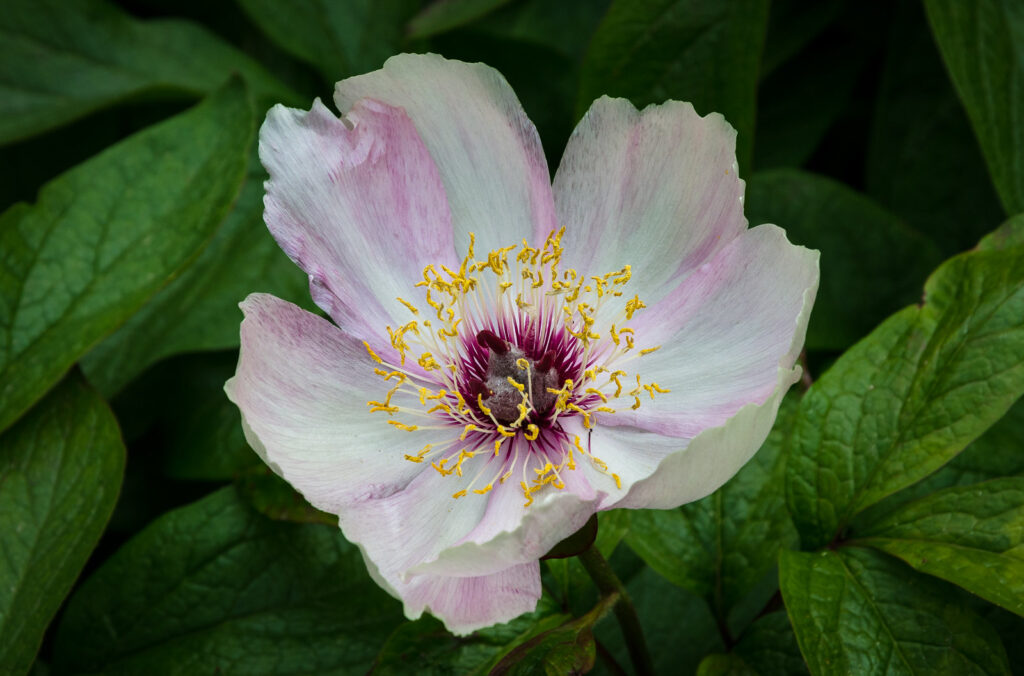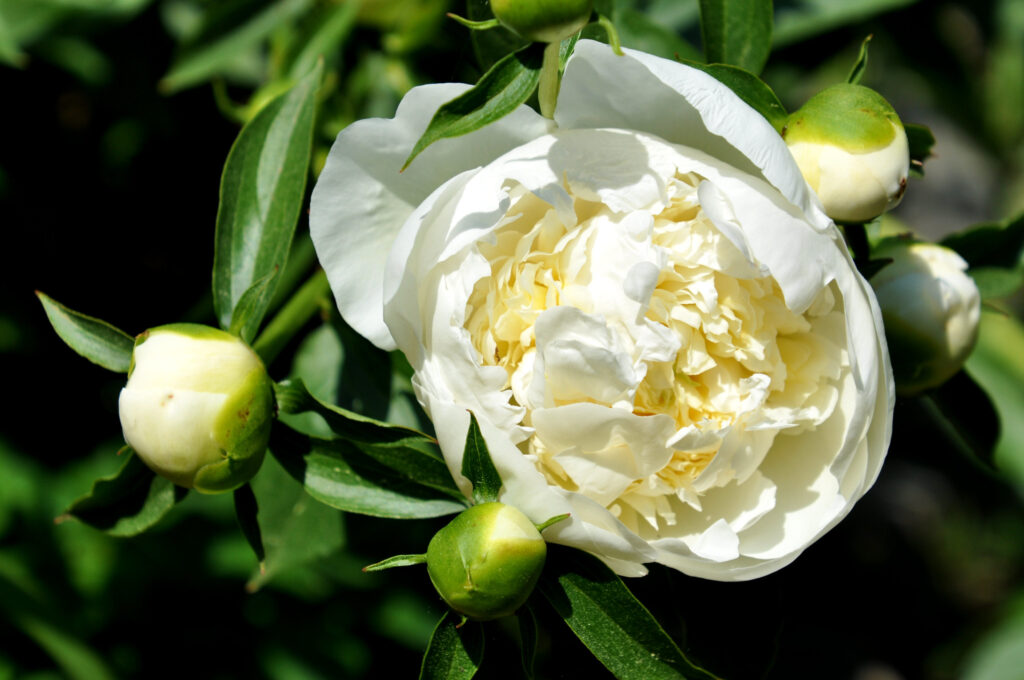Peonies were first cultivated in China thousands of years ago. They were exported to Japan by the 8th Century AD, and then around the world. They have been grown in Europe since the late 1700s, and many varieties grown in Europe and the United States are descended from the peonies first grown on a large scale in Europe in the 1800s. Only two species of peonies are native to the west coast of North America, Brown’s Peony, and the California Peony. Brown’s Peony was harvested by Native Americans as an herbal remedy for lung disease.
Types of Peonies
There are three main types of common peonies: Herbaceous Peonies, Tree Peonies, and Intersectional Peonies (also called Itoh Peonies). Herbaceous peonies are the most common in the west and are native to western North America and Eurasia, usually growing to about 2-3 feet tall. Tree peonies are native to China, and are common in the far east, but are grown around the world. They are commonly between 4-5 feet in height, with some up to 7 feet. Intersectional varieties are crossbreeds that share characteristics. They will resemble the herbaceous parent breed in size and stem length, and their flowers will look like those of their tree peony ancestor.

Tree peonies will lose their leaves and blooms in the winter, but the main structure of the plant stays sturdy and strong. The leaves and flowers then come back in the spring. Herbaceous and intersectional species appear to die back in the winter completely, wilting and going completely dormant, but come back to full strength in the spring.
- Paeonia Paeonia (Eurasian Herbaceous Peonies)
- Paeonia Moutan (Tree Peonies)
- Paeonia Onaepia (North American Peonies)
- Perennial
- Full sun
- Fertile, moist and well-drained neutral to slightly alkaline soil (6.5-7.0 pH).
- Start seedlings, cuttings, or seeds indoors in the late fall
- Transplant them into the garden in the fall of the following year.
- Directly seeded peonies also should be started in the fall.
- Transplants can be started in spring but will grow slowly the first year.
- Plant 36″ apart for healthy shrubs.
- Growing in containers:
Start single plants in at least 12″ deep, and 16″ wide pots
Ensure good drainage and acidic soil
- Water regularly, keeping the soil moist.
- Climate Zones 3-8 for herbaceous, 4-9 for tree, 3-9 for intersectional
Growing Peonies
Overall, peonies are easy to grow, but be prepared to let them grow for a while. It takes a few years for them to start flowering, but they will last a lifetime, and at full size, they will produce a lot of flowers every year. To keep them upright and the flowers displayed in the best way, support is needed. It is strongly recommended that you purchase peony cages to support this multi-branch perennial.
Most herbaceous peonies are purchased as bare-rooted plants when they are about two years old. It’s best to plant them early in the fall, or late in the summer. This allows the plants to grow out their roots before winter starts. They can be started in the spring, but this will require regular watering for the young plants, and they will not grow as fast during the summer months in the first year. It’s important that the flowerbed be placed so that it gets full sun and will drain well. In warmer climates, a little shade is okay. Intersectional peonies (hybrids) should be grown like herbaceous peonies. Some intersectionals will have more heat resistance, and some will do better than herbaceous types in partial shade. Plant them three feet apart. It is usually in the third year of growth that the flowers start to bloom in earnest.

Herbaceous peonies can also be grown directly from seed. For direct planting, plant the seeds in late summer to early fall, and allow them to germinate in the soil. Keep them well-watered. This process allows for warm germination and a cold treatment over the winter months. They should sprout in the spring. Seeds can also be started indoors, in the fall. Use small starter pots, one seed per pot. Plant the seeds about 1 inch deep. Cover the pots and allow them to grow for about three months. At this point, they need cold treatment. Put the young plants in the refrigerator for about three months or so. Once past the last frost, plant the seedlings in the ground four feet apart. This will allow for full-sized shrubs to develop without replanting.
Usually, tree peonies are also started from bare root plants like herbaceous peonies, though more space is needed, usually 4-5 feet between each plant. Using cuttings and seed starting for tree peonies is also possible, though uncommon. Dried seeds should be scarified, meaning rubbed lightly with sandpaper a few times. This speeds up germination. Freshly harvested seeds don’t need scarification. Seeds should be planted in pots to start with and planted in the late summer or early fall of the next year. These should start blooming after about two to three years.
Cuttings are a bit more difficult. In late spring or early summer, dig around the base of a plant carefully, and select several healthy root sections. Cut each root to remove a 6-inch long cutting. Split that into two 3-inch sections. Ensure to mark or cut them so you can tell the top from the bottom, it’s important not to plant them upside-down! Plant them singly in medium-sized pots. Use a compost mix or other non-soil mediums. Ensure that the top of the cutting is at the surface. Start several cuttings, some will likely not germinate. Keep them warm (70°F) and in the dark. Water to keep the soil moist. By early spring some should have sprouted. Move these into the sunlight, and if they grow to a few inches tall, transplant them into the garden bed, the next fall. It can take several years for tree peony cuttings to flower, but it’s worth the wait!
Peonies can easily be grown in containers, but make sure each plant is in its own large, well-draining pot. Ten gallons or a bit more is best. Plant the tubers an inch or two deep in the pot to start with. The plant needs to have space for roots to grow. Use time-release fertilizer when planting. Keep them watered when the soil starts to dry out, throughout their life. It’s good to use support for potted peonies, just like the garden flowers. Fertilize every spring. If you are in a colder climate, move the plants indoors over the winter.
Peony Companion Plants
Peonies do well with some companion plants. Some plants are good as ground cover around the peonies, or as smaller plants that will grow out under the flowering peonies. For herbaceous varieties, it’s important to leave the area immediately around the peony clear so that they don’t have trouble coming back in the spring. Some herbs like sage and thyme are good as ground cover, and smaller succulents like jade or aloe vera do very well. Hyacinth, hydrangea, and even roses and lilacs are great choices. Peonies also do well around some trees, including evergreens and dogwood, though it’s important to remember that they need full sun.

Peony Pests and Diseases
Most often peonies will be disease free, but two fungal blight diseases that are a problem sometimes are botrytis or phytophthora. These diseases have very similar symptoms. The flower buds will fail to open and turn brown, leaves will have black and brown spots. Botrytis can be treated with anti-fungal sprays, careful monitoring, and careful pruning. Phytophthora cannot be treated. It’s a different type of disease. Plants infected with phytophthora should be removed and disposed of (not composted). The soil surrounding the plant should be dug out and replaced. Peonies do have some susceptibility to stem wilt, scale, and canker. They are basically pest free. An interesting fact about peonies is that ants help rather than hurt. Ants crawling over peonies can actually help the flower blooms open up, and deter other types of pests from bothering the plant. They are not necessary for the plants to bloom, but ants and peonies are mutually helpful to each other!
Harvesting Peonies
If you harvest the seeds for planting, be prepared for a peony that looks different from the parent plant, especially if you have different varieties. Cuttings, or dividing an existing plant, is the only way to ensure that you get a true duplicate of the parent. Peonies grown from seed are still beautiful in their own right. Harvest in the fall, when you see the seed pods darken. Pull the tough, thick-skinned pods off the plant, and open them over a container to collect the seeds. Test the seeds by putting them in a large bowl and filling the bowl with water. Discard any sterile seeds, these will float to the top. They can be planted right away, either indoors or directly in the garden, as already discussed. These are almost always long-lived beautiful flowers! Garden Savvy’s garden planner, Hortisketch, can help you achieve the peony garden of your dreams.

Contact Author
 info@gardensavvy.com
info@gardensavvy.com Recent Posts
- Smart Gardening: How Technology Is Revolutionizing Horticulture
- Understanding Gardening Zones: What You Need to Know
- The Right Tools For Your Gardening And Landscaping Needs
- Maximizing Your Harvest: Square Foot Gardening Chart for Beginners
- Holiday Garden Scents: Plants for Natural Aromatherapy in Your Home









